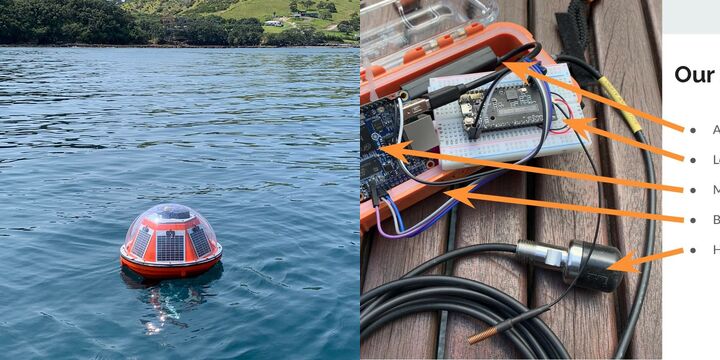Seacology Deter, Detect+Detain
The Problem
It is not cost-effective to police offshore Marine Protected Areas, so they are mostly not protected at all. Patrol boats ($22m to buy, thousands of dollars a day to operate) and aircraft ($140m to buy, $18,000 per hour to operate) are too expensive for developing nations, and satellite-based systems have important gaps which hide the problems. All nations with large sea areas to protect need a cost-effective solution that
Our Proposal
We will operate a constellation of buoys, of two types: Deter buoys will broadcast on Marine VHF, warning fishers they are entering a protected area and face confiscation and jail if they fish here. They will also flash high-intensity red and blue lights for fishermen without VHF. We will back this up with PR in the fishers' home countries warning of the effective new system, perhaps showing the "perp walk" for captured vessel skippers. Detect buoys will use a phased array of passive sonar hydrophones; the on-board processor will classify contacts as fishing boats by the sounds of their engines and gear over time, and the phased array will give direction. Once a contact has been classified as fishing, the Detect buoy will send an short encoded message to a satellite, which will relay it to our cloud service. We can cross-reference with other data sources such as GlobalFishingWatch, Eyes on the Sea, potentially local VMS. We will provide actionable alerts to the local enforcement agency including estimated position (through triangulation of two buoys by our cloud service, or by a single buoy estimating distance by fishing activity pattern). This will let fisheries management agencies triage enforcement actions by likelihood of capture, and perhaps other parameters such as weather, type of fishing etc.
We Assume that...
1. That we can operate an outsourcing "shared service" model, where our development, deployment and operating costs can be recovered across multiple customer governments, each paying a modest amount.
2. That we can gain PR coverage in countries from which craft-scale poachers come, that make them fear capture. This is reinforced by the Deter buoys, and leverages our multiple customer countries.
3. That we can gather enough test data for our sensors, sensor fusion and machine-learning models through the active collaboration of one or more enforcement agencies with marine patrol capability.
That we can continue a collaboration with the Royal New Zealand Navy, which began with some seed funding and a buoy to use. RNZN has the problem we solve, and helps several small Pacific nations too.
Constraints to Overcome
We believe all the technology is within our grasp. We will build on several previous rounds of work, one funded by CXLabs and others with external funding. We have already demonstrated the ability to deploy a machine learning model into a low power embedded system suitable for a buoy; and had a buoy deployed (with different technology, in parallel) for some months in the ocean. We also need to deploy early prototype buoys into known fishing grounds to gather raw sonar data and prove our sensor, sensor fusion and machine learning approaches. Access to that testing resource is probably our biggest barrier, though we do have Navy contacts who may be able to help with that. The other major barrier is credibility when contacting the governments of countries who could use our system. I am sure they are regularly told someone can solve their problem in exchange for money. By being part of our development process, CXLabs could help us with credibility and contacts in the relevant communities
Current Work
Build a service that can provide effective and cost-effective input to protection to Marine Protected Areas and Exclusive Economic Zones. We envisage a differential pricing model so that protecting EEZs, where there is significant potential revenue at stake, can support protecting MPAs too, where the financial case is more difficult to make. Our solution is easy to replicate across countries, so we would set a goal of pilot implementation in one country within 1 year, then three states or countries within the next year and so on.
Current Needs
None of our team works professionally in this area. We need to find people outside the team who can help with technical validation and design input, and potential customers who can provide market validation.

